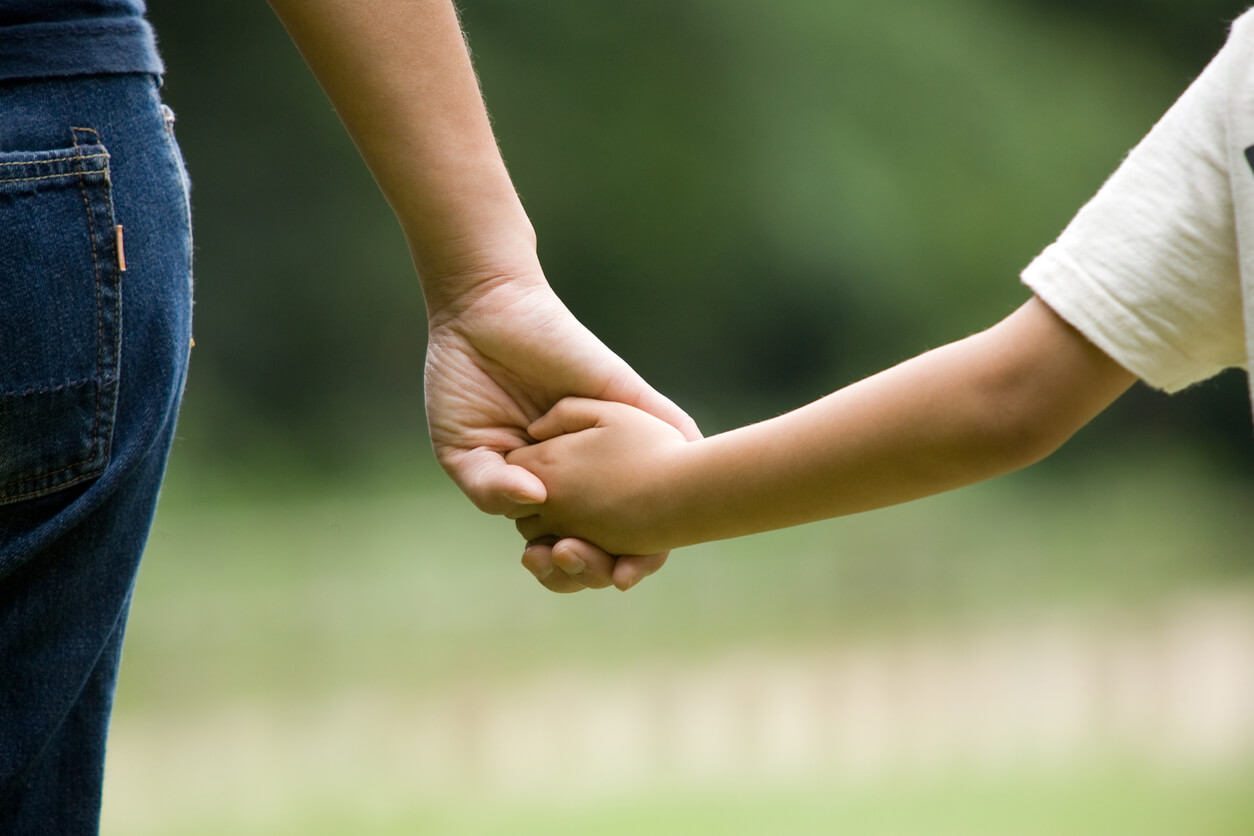How to Instill the Value of Love in Children?

We talk a lot about the importance of love in relationships to improve coexistence and respect. We can identify well the sensations and emotions that we experience when we have loving relationships with respect to those bonds in which we don’t feel cared for. Undoubtedly, affection nourishes our lives. Now, let’s see how to instill the value of love in children.
You may be interested in: How a Baby’s Brain Develops – the Key is Love
Learn how to instill the value of love in children
Some of the recommendations to transmit the value of love to children are the following:
- Let them be the main protagonists. That is, if they receive love, they’ll be able to live it “in the flesh” and experience how it feels. Each parent must find their own style when it comes to showing love: Some will do it through words, others through gestures. The important thing is that children can experience it firsthand.
- Validate their emotions and decisions. To be validated means to be recognized by the other, to be “taken seriously”. Many times, we minimize how children feel because we think it’s “silly” that they cry for whatever reason is making them upset. Or we disregard their preferences because “they’re too old for that”. Teaching them the value of love implies that we give them a place and respect it. Even when certain decisions cannot be followed through with, we must explain to them in an assertive and caring way.

When children live in a loving environment, they understand that this is the best way to live and to bond with others. - Translating love into concrete actions. We often think of love as an abstract concept. However, there are everyday acts that speak to us of a relationship of affection and interest. For example, sharing a meal, asking how the other person’s day was, leaving food ready for someone who gets home late, among other things.
- Love is also about setting limits. Another way to teach “good love” is to show children that limits are healthy and necessary, that they help us take care of them. For example, we may be tempted to eat a lot of chocolate because we love it, but doing so may cause us to have a tummy ache. As they get older, boundaries change as well. Practicing frustration will allow them to appreciate what they have and accept that you can’t always say yes to everything.
- Teach respect. Instilling and promoting good treatment, not using shouting or bad manners when making a request, teaching them not to laugh at others or be an accomplice of humiliation or mockery, are also keys to a love-based upbringing. At the same time, it’s important to avoid using words that can hurt others. Of course, we must be the first to put all this into practice. One of the closest ways children learn to exercise love (and other values) is through caring for a pet. For example, being responsible for taking the dog for a walk or making sure it has food and water. It’s a fun and enjoyable activity to put them to the test.
- Accept people with whom we have differences. We don’t always have to like the same things nor do we have to like all of our companions. These ideas should also be transmitted to children. However, we should have respect for all people, even when we don’t like them. At the same time, let them know that in our relationships, there will also be disagreements. Here there are two options: We can set limits and let them know that we don’t share the same opinion or, at other times, we can also listen to each other and learn from others.
- Trusting each other. One of the greatest signs of love we can show our children is that we trust them, that we believe they’re capable of learning, growing, and achieving their goals. Trust not only enriches relationships, but also helps children develop a solid self-esteem.
- Getting to know each other. Love also implies sharing, talking, and getting to know each other. Knowing what they like and what they don’t like, asking how they feel, what they’re afraid of, or what their dreams are. It’s important to dedicate time to relationships.

You may be interested in: How to Explain What Love Means to Your Children
Love isn’t only a value, it’s also health
It’s crucial to know that, in the bond of love and attachment that’s woven between parents and children, their development and growth is also at stake, as well as the strengthening of other skills necessary for life. For example, those who receive a loving upbringing will have stronger self-esteem, will feel capable of learning, and will see themselves as valuable persons. Undoubtedly, all of this has an impact on health and quality of life. Therefore, love is more than a value that we want to transmit, it offers future and well-being.
Finally, it’s also relevant to know that those children who feel loved will also be adults capable of giving and receiving love.
We talk a lot about the importance of love in relationships to improve coexistence and respect. We can identify well the sensations and emotions that we experience when we have loving relationships with respect to those bonds in which we don’t feel cared for. Undoubtedly, affection nourishes our lives. Now, let’s see how to instill the value of love in children.
You may be interested in: How a Baby’s Brain Develops – the Key is Love
Learn how to instill the value of love in children
Some of the recommendations to transmit the value of love to children are the following:
- Let them be the main protagonists. That is, if they receive love, they’ll be able to live it “in the flesh” and experience how it feels. Each parent must find their own style when it comes to showing love: Some will do it through words, others through gestures. The important thing is that children can experience it firsthand.
- Validate their emotions and decisions. To be validated means to be recognized by the other, to be “taken seriously”. Many times, we minimize how children feel because we think it’s “silly” that they cry for whatever reason is making them upset. Or we disregard their preferences because “they’re too old for that”. Teaching them the value of love implies that we give them a place and respect it. Even when certain decisions cannot be followed through with, we must explain to them in an assertive and caring way.

When children live in a loving environment, they understand that this is the best way to live and to bond with others. - Translating love into concrete actions. We often think of love as an abstract concept. However, there are everyday acts that speak to us of a relationship of affection and interest. For example, sharing a meal, asking how the other person’s day was, leaving food ready for someone who gets home late, among other things.
- Love is also about setting limits. Another way to teach “good love” is to show children that limits are healthy and necessary, that they help us take care of them. For example, we may be tempted to eat a lot of chocolate because we love it, but doing so may cause us to have a tummy ache. As they get older, boundaries change as well. Practicing frustration will allow them to appreciate what they have and accept that you can’t always say yes to everything.
- Teach respect. Instilling and promoting good treatment, not using shouting or bad manners when making a request, teaching them not to laugh at others or be an accomplice of humiliation or mockery, are also keys to a love-based upbringing. At the same time, it’s important to avoid using words that can hurt others. Of course, we must be the first to put all this into practice. One of the closest ways children learn to exercise love (and other values) is through caring for a pet. For example, being responsible for taking the dog for a walk or making sure it has food and water. It’s a fun and enjoyable activity to put them to the test.
- Accept people with whom we have differences. We don’t always have to like the same things nor do we have to like all of our companions. These ideas should also be transmitted to children. However, we should have respect for all people, even when we don’t like them. At the same time, let them know that in our relationships, there will also be disagreements. Here there are two options: We can set limits and let them know that we don’t share the same opinion or, at other times, we can also listen to each other and learn from others.
- Trusting each other. One of the greatest signs of love we can show our children is that we trust them, that we believe they’re capable of learning, growing, and achieving their goals. Trust not only enriches relationships, but also helps children develop a solid self-esteem.
- Getting to know each other. Love also implies sharing, talking, and getting to know each other. Knowing what they like and what they don’t like, asking how they feel, what they’re afraid of, or what their dreams are. It’s important to dedicate time to relationships.

You may be interested in: How to Explain What Love Means to Your Children
Love isn’t only a value, it’s also health
It’s crucial to know that, in the bond of love and attachment that’s woven between parents and children, their development and growth is also at stake, as well as the strengthening of other skills necessary for life. For example, those who receive a loving upbringing will have stronger self-esteem, will feel capable of learning, and will see themselves as valuable persons. Undoubtedly, all of this has an impact on health and quality of life. Therefore, love is more than a value that we want to transmit, it offers future and well-being.
Finally, it’s also relevant to know that those children who feel loved will also be adults capable of giving and receiving love.
All cited sources were thoroughly reviewed by our team to ensure their quality, reliability, currency, and validity. The bibliography of this article was considered reliable and of academic or scientific accuracy.
- Bilbao, Alvaro (2015) El cerebro del niño explicado a los padres. Plataforma Actual.
- Melendres Carlos, Victor. (2019). La importancia de inculcar el valor del amor desde la infancia: opinión de docentes de educación básica. XIV. 36-38.
This text is provided for informational purposes only and does not replace consultation with a professional. If in doubt, consult your specialist.








